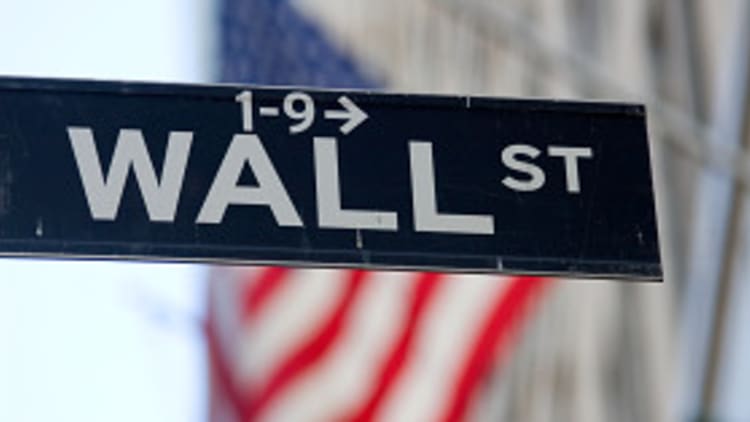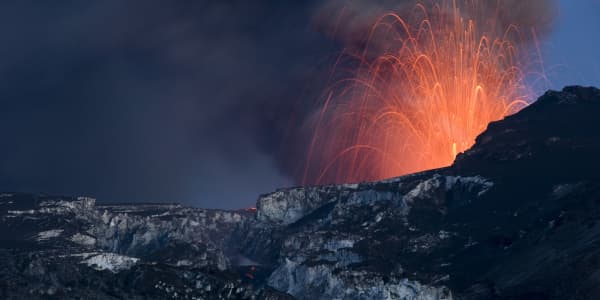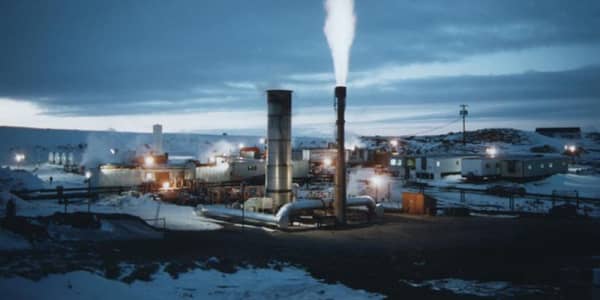
"People think you can just walk right in," the bemused security guard said to his co-worker, who snickered, shook his head and returned to his outpost under the tented area outside the otherwise-regal entrance to the New York Stock Exchange.
The dejected tourist walked away after learning that, no, there is no visitors' gallery at the exchange where he could watch what was happening inside. He then disappeared into a dense crowd of tourists browsing the mall around the exchange one pleasant early April day. Apparently, the man had made multiple efforts—"guard shopping" as one of the security personnel put it— to get a look at the trading inside the confines of 11 Wall St.and was unsuccessful each time.
Nearby, folks posed in front of the George Washington statue at Federal Hall, across the walkway from the exchange. They aimed their camera phones curiously around Broad and Wall streets, many drawn to the enormous American flag that flies in front of the NYSE, where it has stood proudly since shortly after the Sept. 11, 2001, terror attacks.
And they wondered what was going on inside. This is, after all, supposed to be the financial capital of the world, so there must have been some really amazing beehives of activity happening.
If they only knew.
Read MoreJamie Dimon—the most influential on Wall Street?
Truth is, there's really not that much to see anymore inside these majestic halls.
An exchange that used to house more than 5,000 traders shouting out their business now is a mostly docile habitat in which those still left on the floor quietly tap out orders on hand-held computers and barely make a peep at swift changes in market activity.
Things indeed have changed a lot for the exchange over the past 25 years.
The next 25 years—well, things could get dicey.
Will the exchange still exist? Will it be a museum? An office complex? An automated emporium run by robots?
More importantly, will New York still be the financial capital of the world?
Nobody seems quite sure, though the building itself does maintain its nostalgic appeal even if it's lost much of its relevance as a trading center.
"Symbols matter," said Nicholas Colas, chief market strategist at New York-based brokerage ConvergEx. "It's important to have a symbol that people can relate to, and it's much easier to relate to a physical space. It will be important for the New York Stock Exchange to maintain some relevance with investors."
Read MoreFinance kings: The bailouts, bonds and bubbles
As things stand in 2014, the prospects for 2039 for the building and what happens inside it hinge on three things: Just how far the trading community pushes automation, how hard regulators push back and how well the 80 or so locations now where stocks are traded can maintain their trust and credibility with the investing public.
A Rapidly Changing Ecosystem
New York faces a bevy of challenges. Automated trading has taken up about four-fifths of the market's volume. Dark pools—privately run trading centers away from the NYSE—are scattered around the metropolitan area. Exchanges around the world such as those in Tokyo, London and Shanghai are seeing their volumes increase, though they still draw just a fraction of the volume seen in New York at the NYSE and the Nasdaq.
The current market is dealing with one whale of a black eye caused by suspicion over high-frequency trading and its stranglehold on market activity. The proliferation of trading aberrations such as 2010's "Flash Crash" and the intense debate over Michael Lewis' HFT-centered book "Flash Boys" has underscored the credibility problem, which will have to be rectified—and soon—if the market is to have a future in 2½ decades.
Conversations with the folks who help make the market machinery work reveal some interesting—and surprising—thought trends.
For instance, there is a pervasive belief that the market will become less fractured and perhaps even a bit slower than the current incomprehensible millisecond-moving speeds. While automation is a fact of life, there is no widely shared dystopian view of a market run by faceless machines without accountability.
There's even a bit of whimsy.
Read MoreMilken to Madoff: Villains who changed the world
Market veteran Art Hogan peered into his crystal ball at CNBC.com's request and saw two megamergers that would shake Wall Street at its core. One would see Facebook and Twitter join to take over the New York Stock Exchange; the other would have Apple and Google combine forces to wrest control of the Nasdaq, which trades mostly tech stocks.
In the Hogan scenario, the two mammoths blow out the rest of the 80 or so exchanges and dark pools where trades currently take place and defragment the market. At the same time, regulators change trading "ticks," or the increments in which stocks can trade, from the current decimalization to nickel sizes, eliminating the benefits that high-frequency traders enjoy from capitalizing on moves of pennies.
Hogan is kidding ... sort of, but in a way that indicates the general direction the market needs to trend to win back investor confidence.
"You've got a world (in 25 years) where technology, social media and financial markets have come together to increase investor confidence in markets," said Hogan, the chief market strategist at Wunderlich Securities. In his future vision, "Wall Street gets to play its role again as the greatest place to form capital for emerging companies, and to research those emerging companies."
Don't laugh too loudly.
Read MoreCNBC First 25: Top 100 Contenders
Hogan's scenario of a market that undergoes massive transformation that actually benefits the retail investor and re-establishes some sanity in a market that has lost so much of its trading volume over the years is a widely shared vision.
"We're moving faster and faster. The speeds are incredible, but we're going to get to the point where it doesn't go any faster," said Peter Costa, president of Empire Executions and an NYSE governor with 33 years of trading experience.
A Quieter Street
In the Costa scenario, trading changes completely.
In a future world where cash becomes marginalized and digital "credits" take over as a system of payments, companies find old-fashioned stock issuance a trite method of raising funds. Stocks, meanwhile, start to more closely resemble mutual funds, with very little if any price movement during market hours and instead "a final pricing at the end of the day," Costa said.
"There will be more financial options for investors," said Todd Schoenberger, managing partner at LandColt Capital. "For example, we now have stocks, bonds, mutual funds, etc. Look for new products to enter the market, which will be a real hassle for regulators. But, expanded options is what you get when you have too many players transacting business."
Whatever form trading takes—high speed, low speed or no speed—what will matter most is fairness, and many Wall Street pros expect Washington regulators to continue their pursuit of an equitable environment.
"What they're realizing is money managers like myself don't care about getting a sell in half a second," said Michael Cohn, chief market strategist at Atlantis Asset Management. "I don't care about the pennies, I care about the perception and the fairness. It affects my business if people think the market is not fair."
If there is a common theme in terms of hopes for the future, it indeed would be some simple fairness.
"You can still have automation, but it would be nice to bring back some sort of ecosystem into it," said Joe Saluzzi, co-founder of Themis Trading and an ardent campaigner against the ills of high-frequency trading.
I don't think the NYSE exists anymore period...It's a historic oddity.Dick Bove
Saluzzi hopes the next 25 years hold a greater emphasis on human involvement, not less.
"You like to have someone involved. The investor relations officer, the chief financial officer, really has no idea what's going on in their stock," he said. "There are no specialists involved. They need more information as to what's going on. It's not there anymore."
While the amount of bodies on the exchange floor indeed has dimmed considerably over the years, the level of employment in financial services has remained fairly and surprisingly resilient.
Financial services jobs peaked out in late 2006 at about 8.4 million, according to the Bureau of Labor Statistics. While that level certainly has declined, the nearly 6 percent drop to 7.9 million as of March 2014 could have been much worse considering the way Wall Street banks cut jobs en masse during the crisis.
A Shift to Markets Abroad
Expectations, though, are for even fewer footsteps on the Street.
"The amount of employees that will be working on Wall Street, if you want to call it that, is going to continue to go down year after year," said Marc Pfeffer, a former trader at Goldman Sachs and the defunct Bear Stearns who now works as a portfolio manager at CLS Investments. "I am perplexed til today to understand why there are that many people at these firms. I think they're going to be cut by a huge percentage, if they even exist at all."
So where does that leave the exchange as a physical property?
If you close your eyes tightly enough you can almost see the tumbleweeds rolling across the cobblestones past the Wall Street subway station, past the Deutsche Bank building and gliding on a path to nowhere. After all, what possible use could there be for such a structure in the next age of trading?
"I don't think the NYSE exists anymore period," said Dick Bove, the outspoken banking analyst and vice president of equity research at Rafferty Capital Markets. "I think it's a good television set for you guys."
Well, there's that. It's true that on some days the most excitement comes from the guests that CNBC and other media attract, whether that's market veterans like Kenny Polcari, CEOs such as AIG's Robert Benmosche or professional celebrities like Kim Kardashian. But is it possible the building will serve no function?
Bove sees the global financial center shifting from New York only to various other places around the world—Canada, China, wherever countries are committed to a thriving banking sector and not obsessed with handcuffing "too big to fail" institutions. He also points out that the exchange isn't even owned by a New York firm anymore, and that most of the trading happens at high-frequency nerve centers in New Jersey.
Other challenges New York faces include its inability to attract technology-focused industries, intensified regulation from city and state politicians, and the rise of financial centers around the world that will provide major competition.
All those factors, he said, will make the NYSE, if not obsolete, at least substantially declining in relevance.
"It's a historical oddity. It should be given to one of the historical preservation societies," Bove added. "It does not exist today. It will not exist in 25 years."





